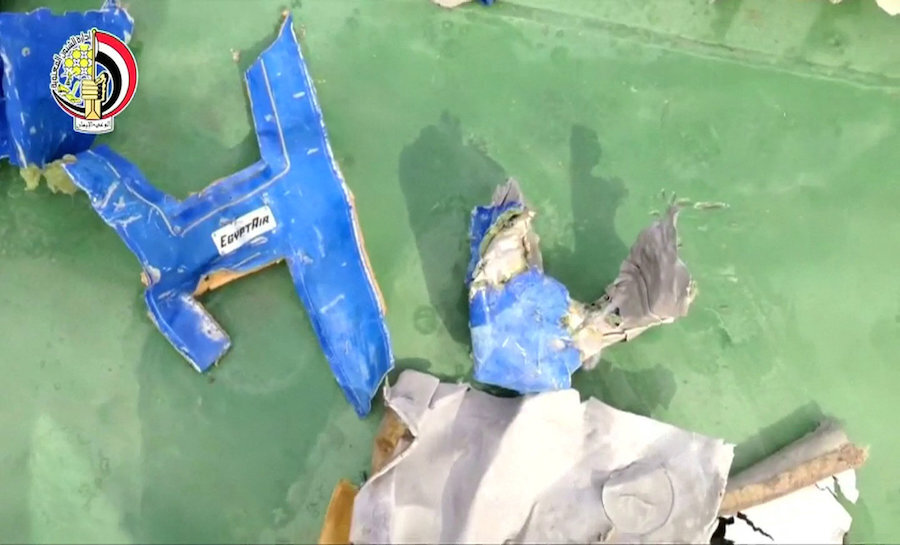Smoke detected on EgyptAir Flight 804: What does that mean?
Loading...
Aviation experts are still attempting to piece together what caused EgyptAir Flight 804 to crash into the Mediterranean sea early on Thursday, even as more data adds to the mystery.
Several smoke alarms were activated throughout the plane before it went down, the French agency charged with investigating air accidents, the Bureau of Enquiry and Analysis (BEA), confirmed Saturday. BEA officials said that automated systems onboard the plane sent messages indicating smoke was filling the aircraft a few minutes before the fatal crash, according to the Associated Press.
What does that mean for theories about the cause of the crash – from pilot error to mechanical malfunction to terrorism? The picture remains hazy, BEA agency officials said.
The messages "generally mean the start of a fire," Agency representative Sebastien Barthe told the AP. "We are drawing no conclusions from this. Everything else is pure conjecture."
The EgyptAir flight 804 left Paris on Wednesday night for a routine flight to Cairo, Egypt. Shortly before it was expected to start its descent, the plane made a jerky 90-degree turn to the left followed by a 360-degree turn to the right before crashing into the Mediterranean Sea.
A search-and-rescue operation has been led by Egyptian officials in combination with several other countries. On Saturday, the Egyptian military release photos of debris found from the crash, including damaged seats and luggage. No survivors have been located.
The exact cause of the unusual maneuvers and subsequent crash are still unknown, but Egyptian minister of civil aviation, Sherif Fathy, indicated he believed it was more likely an act of terrorism that caused the crash than a mechanical malfunction.
The new data from the Aircraft Communications Addressing and Reporting System (ACARS), an automatic reporting system that indicated a fire had started on board, neither fully confirms nor denies an act of terrorism. But this data does provide a clearer direction for investigators to search.
The data “doesn't tell us anything, whether it's an explosion because of a bomb or because of a mechanical fault, but immediately it narrows down the area that we're looking at," aviation analyst Richard Quest tells CNN. "We're now no longer worried about wings or what else might have happened, or other flight control surfaces."
To someone outside the flight industry, the automated messages are largely enigmatic:
00:26Z 3044 ANTI ICE R WINDOW
00:26Z 561200 R SLIDING WINDOW SENSOR
00:26Z 2600 SMOKE LAVATORY SMOKE
00:27Z 2600 AVIONICS SMOKE
00:28Z 561100 R FIXED WINDOW SENSOR
00:29Z 2200 AUTO FLT FCU 2 FAULT
00:29Z 2700 F/CTL SEC 3 FAULT
The Telegraph spoke with a European pilot that helped decipher the messages. The time stamp at the beginning is set to Zulu time, the same as Greenwich Mean Time (GMT), a universal time used by ships and aircraft to coordinate globally. The times indicate the events happened around 2:26 AM.
The location that follows the time-stamps reveal a series of catastrophic failures that took place in the plane prior to the crash, which rules out the possibility of a deliberate crash by the pilots or a hijacking.
David Learmount, a consulting editor at Flightglobal, who analyzed the Airbus 320 fault warnings in his blog, writes that sensors indicate that a fire broke out first in the lavatory closest to the cockpit and a minute later smoke is recorded in the avionics bay, close to that same lavatory:
The question now is whether the fire that caused the smoke was the result of an electrical fault – for example a short-circuit caused by damaged wiring – or whether some form of explosive or incendiary device was used – for example by a terrorist – to generate a fire or other damage.
The fire appears to have propagated fast. Flight control computers were failing within two minutes of the avionics bay smoke warning. If more of them failed subsequently the pilots would have limited means for controlling the aircraft, and with fire present, crew stress would have been extremely high.
The Telegraph reports that the signals likely indicate an internal explosion that could have blown out windows from the inside out and started a fire on board. An external explosion, like the missile that brought down Malaysia Airlines flight MH17, would have caused more alarms to trigger.
Although industry analyst Robert W. Mann tells The New York Times that a fire onboard was not necessarily the only way to cause the automated messages. "The messages could also have been prompted by rapid decompression of the aircraft, which can produce condensation that the plane's sensors could mistake for smoke," Mr. Mann said.
But without being able to contextualize the data with the help of the flight data recorder and voice recordings taken from the cockpit, often known as black boxes, the ACARS messages alone leave nothing definitive, according to experts.








